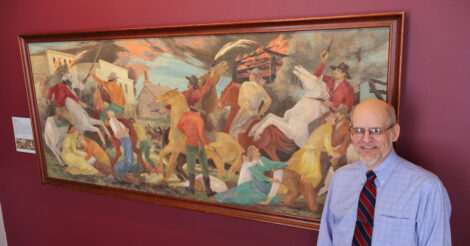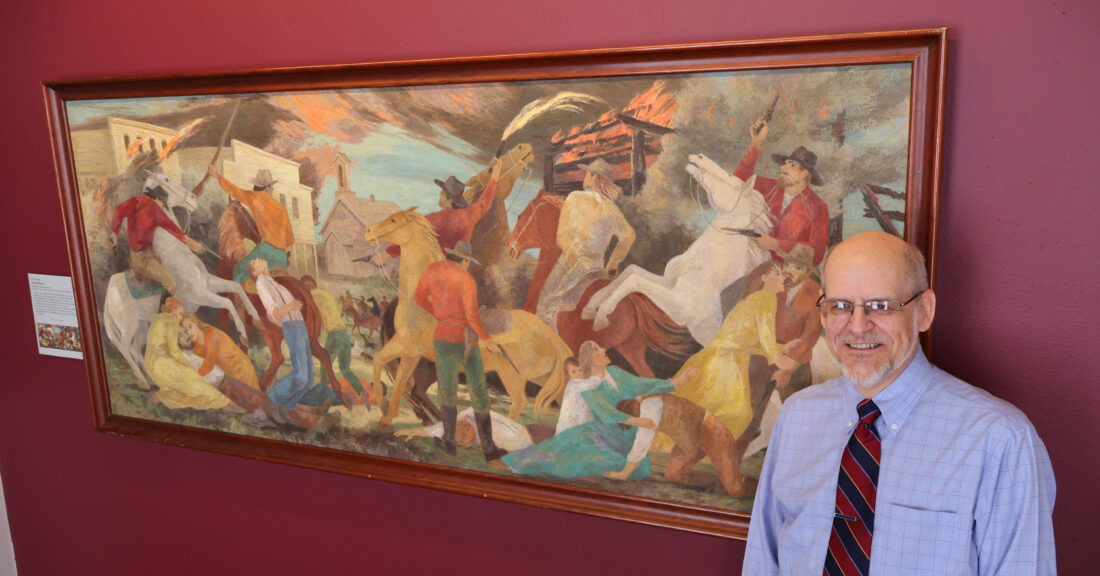
photo by: Chris Conde/Journal-World
Watkins Museum Executive Director Steve Nowak is pictured on Thursday, Aug. 16, 2024, with “Lawrence Massacre” by Ethel Magafan which is on display at the Watkins Museum of History at 1047 Massachusetts Street.
What did the chaos and destruction of Quantrill’s Raid in August 1863 look like? On some level, we don’t really know.
There are no photographs of the bloody, chaotic attack in the middle of the Civil War by William Quantrill and his guerrilla group. The closest thing we have, according to the Watkins Museum, is a single sketch, drawn from memory by a survivor of the raid.
Yet if you look around the Watkins’ new exhibit, “Art of Tragedy: Depictions of Quantrill’s Raid,” you’ll see about 10 visions of it by artists of the 19th and 20th centuries — some smoky and realistic, some colorful, some that even border on cinematic.
Artists were key in shaping how people thought of the tragedy in the 19th century and in how they perceive it today, and Steve Nowak, executive director at the Watkins Museum, said the exhibit is meant to highlight how they did that.
“We’re looking at this a little bit more like art as part of the tradition of artists portraying historic events and the way they convey the importance of that event, or the tragedy of that event, how they use artistic devices in order to be able to convey that,” Nowak said.
That’s a rather different approach from Watkins’ permanent exhibits, which focus on physical artifacts and historical narratives about the attack that killed between 150 and 200 people and destroyed more than two-thirds of the city’s homes.
But one of the earliest works on display in the temporary art exhibit has that eyewitness quality, too. It’s a sketch (technically, a print of it) titled “Attack on Lawrence” that was drawn shortly after the raid by Sherman Enderton, who was in Lawrence serving in the 11th Kansas Infantry at the time.
It’s a jumble of houses, horsemen and corpses — two Lawrencians lie dead in the foreground as a raider shoots another one — and the top half of the composition is shrouded in thick waves of smoke.
photo by: Chris Conde/Journal-World
“Attack on Lawrence” by Sherman Enderton, a member of Company E with the 11th Kansas infantry. Enderton witnessed the raid and sketched this depiction shortly after and this print is on display at Watkins Museum of History through November 2024.
The exhibit also includes period illustrations from magazines, most of which were more focused on the shock of what happened than on depicting the scene and the city accurately.
“In the 1860s, artists didn’t feel compelled to portray the event in a real historical way,” Nowak said. “What they wanted to do was convey the tragedy of the event.”
Other artists since then have tried to add historical touches to their depictions of the raid. That’s true of the piece that Nowak said inspired the exhibit in the first place, “Lawrence Massacre” by Ethel Magafan, which the Watkins Museum acquired only recently.
Magafan painted this work, full of fiery reds, golds and oranges, around 1979, but the idea for the piece came much earlier. She originally conceived of the design in the 1930s as part of a competition seeking artwork for the Fort Scott post office. Her design wasn’t selected back then, Nowak said, but 40 years later, some of her art collector friends learned about it and commissioned her to turn it into an actual painting.
“She went back to her original concept, but made one change,” Nowak said. “What she did was put in an image of Lawrence’s first Methodist church, which served as the morgue during Quantrill’s Raid. So she made it a little bit more particular and specific.”
The museum still has some parts of the Methodist Episcopal Church, which sat at 724 Vermont St. and survived the raid despite its proximity to the Eldridge Hotel which was famously burned, Nowak said. The church was torn down in 1940.
photo by: Chris Conde/Journal-World
Pieces recovered from the Episcopal Methodist Church on display at Watkins Museum.
The exhibit contextualizes Magafan’s painting and the other works on display by pointing out similarities between their composition and other classic works of art. Magafan’s painting in particular is compared to 17th century Baroque depictions of the biblical Massacre of the Innocents.
Another work from the ’60s or ’70s is also on display, and there’s a possibility it might have hung in the Watkins building before.
It’s “Quantrill’s Raid” by Alvin J. Howell, and it’s a composite of several scenes — women wailing by a body, the raiders riding through the town, rows of graves — separated from one another by swirling smoke.
The painting was commissioned for Lawrence City Hall, but around the same time, City Hall moved from the building that now houses the Watkins Museum to its current location on the Kansas River. Nowak said the history of the painting isn’t clear enough to be able to say whether it ever hung in the old City Hall building, or whether it was only hung in the new riverside location to commemorate that building’s completion.
One thing that is sure about the piece is it reflects the era in which it was painted, Nowak said.
“I think that sometime in the 20th century, as movies took over, that’s how people sort of imagined the West, that these paintings are, they’re kind of cinematic. They look like different scenes from some sort of movie,” Nowak said.
“Quantrill’s Raid” by Alvin J. Howell on display on Aug. 16, 2024, at Watkins Museum.
But before the movies, back in the 1860s, scenes of the raid in magazines did just as good a job of capturing the nation’s attention, and Nowak hopes the exhibit demonstrates how big of an event the raid was outside of Lawrence.
“People in New York and Washington, D.C., and Philadelphia … probably had no idea what Kansas was like, but when Quantrill’s Raid took place in relatively quick succession, after the Battle of Gettysburg and the Siege of Vicksburg, then the nation’s attention turned to Lawrence, and we were on that same scale for a period in the fall of 1863,” he said.
The anniversary of Quantrill’s Raid is Wednesday, Aug. 21, but the exhibit will be open to the public until Nov. 9. For more information about the exhibit and other Lawrence history, visit the Watkins Museum’s website at watkinsmuseum.org or stop by the museum at 1047 Massachusetts St.

